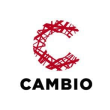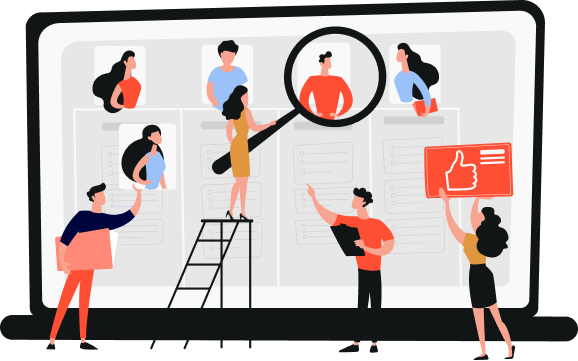Reviews 5 – Rating 4.8/5
Services
Our goal is to provide a full-fledged development process using top-qualified IT experts. We have five offices all in all: Project Management, Business Analysis, Software Development, Design, and QA. For your project, we will pick the best pros from each department. We also have access to a pool of other talents that deal with software and web/mobile development. Whether you need specialists from the beginning or somewhere in the middle of your work, you can turn to our service for prompt help! We deal with all the major phases.
Discovery Phase in Product Development
The discovery phase increases the chances of project success. It goes before the development phase. Creating an app or website without a discovery phase is as risky as building a house without an architectural plan. This phase shows how the project will function, what it will look like, and how it will help your business achieve its goals. At this stage of software development, the sides define the main objectives and scope of the project, timelines and user expectations, and a step-by-step development plan, including the technologies to be used.
Our team sticks to the Software Development Life Cycle (SDLC). We never skip such tasks as gathering and analyzing requirements or designing a product at the initial stage.
Our team sticks to the Software Development Life Cycle (SDLC). We never skip such tasks as gathering and analyzing requirements or designing a product at the initial stage.
We primarily use the project discovery phase to do the following:
- Detect requirements
- Align requirements with objectives/budget
- Tailor architecture concerning objectives and expectations
- Set priorities based on the objectives, needs, and technical nuances
- Tailor requirements to demands of third-parties
- List and explain requirements to the engineers

Why Does a Discovery Phase Matter?
At this stage, the most effective interaction between the client who needs a software solution and IntelliSoft takes place. Together, we discuss the project details, helping each other to more clearly articulate the requirements for the software. The result is the formation of the main regulation the developers rely upon in their work. The Tech requirements should fully describe the tasks for developers and explain the ultimate goal of the project from the customer’s side. Here’s how you can benefit from the discovery phase of a software project.
Improved communication
Even a good presentation cannot guarantee that you have chosen the right software partner. Regular communication during this phase allows you to assess how our team works, our experience and approach to the project development, as well as establish mutual trust and respect. You can use the results of the discovery phase with other IT vendors before launching the development process.
Risk management & control
Clear project goals and requirements help you accurately estimate development time and budget. The discovery phase lets you identify all potential risks from the start, so you don’t have to redo everything entirely later.
Detailed road map
You will get a complete project timeline with intermediate goals, deliverables, and deadlines. The Software Requirements Specification (SRS) and layouts developed during the discovery phase can be used to find additional investors.
Discovery Phase Stages
The discovery process involves experts such as business analysts, PMs, marketing specialists, tech architects, QA engineers, and UI/UX designers. However, every step of the discovery process is impossible without customer input.
The main goal of this phase is to eliminate any unknown elements, get ready with a tech ground, and prepare UX design. Finally, it’s about estimating the time and budget necessary to carry out the project. The steps are:
The main goal of this phase is to eliminate any unknown elements, get ready with a tech ground, and prepare UX design. Finally, it’s about estimating the time and budget necessary to carry out the project. The steps are:

MVP Development Services
A minimum viable product is the stage of development of a startup or IT product when it solves at least one fundamental user problem and demonstrates its “viability.” At the MVP stage, the product has users who can praise or strongly criticize it but still use it, confirming the need the product solves. Vice versa: if, at the MVP stage, a product does not solve significant user problems or solves them poorly, the market does not need such a product and, therefore, it is “unviable.” We will advise you on how to take the first path, from explaining the minimum viable product definition to its implementation.
Benefits of MVP
Not that you know what MVP stands for, consider its advantages:
- Confirm the idea viability and test product hypotheses with real data
- Identify trends that can be used in the development of the full product version
- Reduce the risk of major financial losses if the product is unsuccessful
- Minimize development costs by prioritizing important and identifying useless features
- Speed up bug detection and internal product testing
- Gather a user base before a full-scale launch
- Occupy a market niche and attract investors before competitors

Steps of the MVP Development
Get ready with the basis for your MVP software before getting to the development. MVP development begins with analytics. By the time you get to the development process, you are supposed to have an idea and an “intuitive understanding” of what your users need and what they will be willing to pay for in the long run.
It’s a good time to put those ideas to the test. Things tested at this stage:
It’s a good time to put those ideas to the test. Things tested at this stage:
- What problem or task does your product solve? What’s new about what you do?
- Who will use this product? Who are your consumers?
- How are they solving their problems now? What competitors, analogs, or substitutes already exist on the market?
- What is your market and its possible volume? How fast is it growing? Who is the market leader?
- What kind of business model will you have? How fast will you grow? What will make users talk about you? What will get users to choose your product?
- What kind of team do you have? What kind of experience do you have? What personally motivates you to pursue this product? What results do you personally want to achieve?
It is not a complete list of questions. You can see more here. Good analytics will help you to avoid a mistake and work through the idea before you write the first line of code for your MVP.
Our Success Stories

GrowthWheel
The client needed help with developing a toolset for automating the interaction between consultants and their clients. The InteliSoft team has successfully converted the offline business tool into a SaaS and launched an MVP.

Daintel/Cambio
We helped the client develop a platform’s MVP for collecting, storing, and disseminating data from bedside medical devices and shared data across ICU (Intensive Care Units), NICU (newborn intensive care unit), Surgery/ Anesthesia, and Recovery departments.
Download Full Portfolio with Our Previous Projects
The best proof of our work is the portfolio with past projects. Our happy clients share why they trust us. Check out projects we delivered for clients from various industries.
Scrum Metrics for MVP Development
Our team prefers the Scrum methodology. Such metrics help ensure project health, follow the development plan, guarantee team performance, and identify threats or demands for changes.
- Product quality
Our team checks if each feature successfully passes each examination. IntelliSoft selects a complex method to track and evaluate actionable metrics. Our goal is to ensure that the piece of software meets all customer requirements.
- Predictable burndown
Our team fully controls project health and follows the plan.
- Resolution time
In case the time necessary to carry out a project extends, our experts extend the team size.
- Team velocity
Our PMs assess the team velocity and every participant in particular. We are here to ensure your project is on track and any delays are excluded.
CTO as a Service
What is a CTO? The Chief Technical Officer (CTO) is the expert involved in all product development processes. This person is in charge of choosing the project’s tech stack, working out the architecture, and ensuring that the developers have no problems with implementing design solutions and working with development tools. Their main responsibility is to ensure all business goals are met and development processes are well established.
Why Does Your Start-up Need a CTO?
Get ready with the basis for your MVP software before getting to the development. MVP development begins with analytics. By the time you get to the development process, you are supposed to have an idea and an “intuitive understanding” of what your users need and what they will be willing to pay for in the long run.
It’s a good time to put those ideas to the test. Things tested at this stage:
It’s a good time to put those ideas to the test. Things tested at this stage:
- You have a great product idea but have no idea how to implement it.
- You have developed your first product or part of an app but realize its architecture does not match the later stages of your product/service development.
- Your business needs an expert with years of tech leadership experience who can help build the product, effectively discuss the technical aspects with investors, evaluate contractors, and create tech roadmaps for the project.
- At this stage of your company’s development, you do not need a full-time technical director. Still, you need the maximum level of flexibility and cost efficiency, allowing you to pay only for those services that your business needs.
- You need an objective perspective on various tech issues, as well as an expert to guide your development team.
If you agree with at least one or more of these statements, CTO outsourcing services is something that can be helpful.
Hit Your Business Targets with CTO Services
CTO responsibilities include a lot of things that almost every software product company may ever need.
R&D
Managing research and technology development, maintaining up-to-date info on technology standards and compliance policies, research, and recommendations on the most effective solutions, etc.
Short-term & long-term tech strategy
Monitoring technological, social, and scientific trends that can affect the company’s business goals, participation in management decision-making, and identification of business risks and opportunities.
DevOps and MVP
Building the technical aspects of products from scratch, solving tech problems related to the first product iteration, backups, workflows, budgeting for MVP project rework, and more.
Tech design and platform selection
Managing research and technology development, maintaining up-to-date info on technology standards and compliance policies, research, and recommendations on the most effective solutions, etc.
QA, product testing, and cybersecurity
Distribution of tasks between team members related to product and MVP testing and debugging, alignment of QA and technology approaches, development of security procedures and algorithms, emergency audits, etc.
Technology Scouting For Open Innovation
Large companies are interested in expanding the funnel of technological projects, but they do not always understand the scientific language and tech peculiarities. IntelliSoft will find teams or technologies to solve your problems and help launch projects of any complexity.
The Technology Scouting service from IntelliSoft is a structured way of creating solutions to resolve the relevant business issues. It is about defining and choosing the proper “foundation” for your product, should it be a whitelabel marketplace app, a Backend-as-a-Service (BaaS) platform, or an open-source booking engine.
Why Do You Need Technology Scouting Services?
Scouting is an effective tool for finding new solutions and technologies on the market that can be implemented in your company. It is a source of startups and teams for investing, outsourcing and launching joint projects.
IntelliSoft has been providing technology scouting for over ten years. We work with our own project funnel and a network of international partners to successfully solve scouting tasks in different industries. Here is when you may need our services:
- You think about launching MVP in the near future.
- You wish to examine your product hypothesis without significant financial and time investment.
- You would like to compare and contrast funds and timelines of a custom development method to make more informed decisions.
- You have to decide whether it’s possible to base your solution on another app with no need to develop the most typical features on your own/with a team.
- You desire to come up with your own software development strategy based on a smart investment plan.
- You need to obtain a “hacked” intelligent solution for your business problem without investing too many resources.

How We Scout Technologies
Our team continuously explores the market to detect the best solution for tech scouting. We analyze time-tested industry practices and approaches to offer an excellent IT solution, easy-to-support and fast to scale. Technology Scouting consists of the next stages:
FILTERING
• Observe and assess product concept and vision.
FILTERING
• Solution summary development.
• Choice of a couple of basic solutions.
SCOUTING
• Solutions scouting.
• Solution features and tech documentation.
ENGAGEMENT
• Functional decomposition of chosen solutions.
• Choice of the best-fitting solution for the software.
• Comparison of the decomposed features to the custom application’s functionality.



